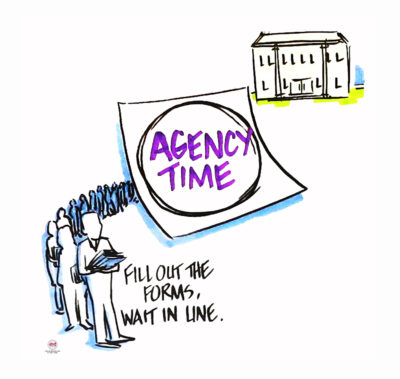 A manager friend of mine once had an employee who disappeared every Tuesday at 1 p.m. My friend finally confronted her employee about the missed work time, and the employee sheepishly said it was her day and time to go to the local food bank. My friend had no idea her employee was living in an environment that was this unstable. She had to ask herself, If I did not have enough resources for today, let alone for tomorrow, what would I do? The answer? She would head to the food bank.
A manager friend of mine once had an employee who disappeared every Tuesday at 1 p.m. My friend finally confronted her employee about the missed work time, and the employee sheepishly said it was her day and time to go to the local food bank. My friend had no idea her employee was living in an environment that was this unstable. She had to ask herself, If I did not have enough resources for today, let alone for tomorrow, what would I do? The answer? She would head to the food bank.
Agency time is defined as time spent going from nonprofit agency to nonprofit agency in the hopes of meeting daily needs. Food, utilities, transportation, childcare assistance, and more often come from agencies. Working with each agency takes time. With only 24 hours per day, an under-resourced person often has to make choices between work and agency time. The closer one gets to survival and needing the resources of agencies, the less time can be spent on learning abstract knowledge—knowledge needed in the workplace. Employees who are living in daily instability spend available time and resources on survival.
“The need to act overwhelms any willingness people have to learn.” —The Art of the Long View by Peter Schwartz
Most nonprofits provide services Monday through Friday from 8 a.m. to 5 p.m. or from 9 p.m. to 6 p.m. If an employee works first shift during the week and needs assistance from an agency, then they are going to miss work to get their basic needs met. We would do the same for our household and loved ones.
As resourced individuals, during the workday we are not thinking about making rent, if there is money for food that evening, and if the pipes will freeze because the heat has been turned off due to nonpayment. As resourced individuals, we are focused on achievement and company goals. Such is not the case for employees who don’t have enough resources to make it through the week or month. Many frontline, entry-level, lower-wage employees are constantly juggling the pressures of family, housing, health, transportation, childcare, elder care, etc., without the appropriate resources. When one doesn’t have resources, one can’t solve the issues at hand.
One fantastic way to support all employees is with a resource network and coach. Resource coaches are often part of resource networks, private–public partnerships that focus on improving workplace retention through employee support. Coaches spend time inside businesses on a weekly basis to help employees solve problems while they are at work. This improves retention and productivity. According to ERN USA, the top reasons employees used a coach in 2020 were government agency navigation, financial literacy, housing, health insurance, counseling, transportation, food assistance, and childcare. The average ROI across businesses is 873%. What is not to love about that?
One of the outcomes of the COVID-19 pandemic is that employers are rethinking the future of the workplace. Employees are demanding it. We can’t afford to lose more employees—we don’t have enough now. One way we can envision a new workplace culture is by implementing policies and benefits that best support the demographic of employees living in daily instability.
To learn more about agency time, resource networks, and your employees living in daily instability and how that impacts the success of your business and your employees, join the Workplace Stability workshop on October 28. Register and learn more today.








